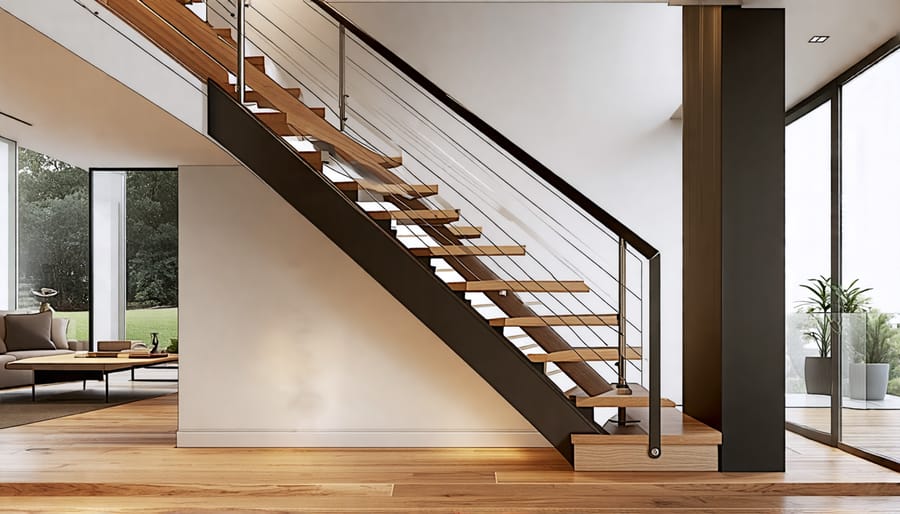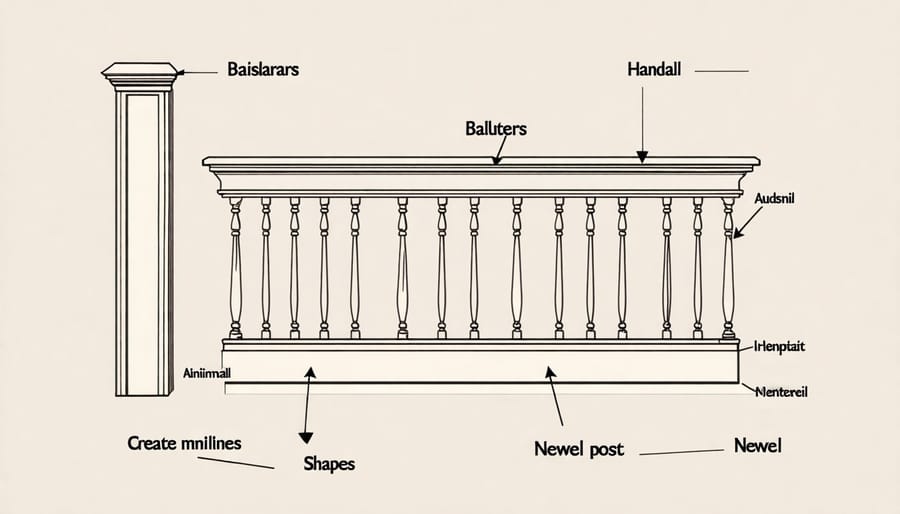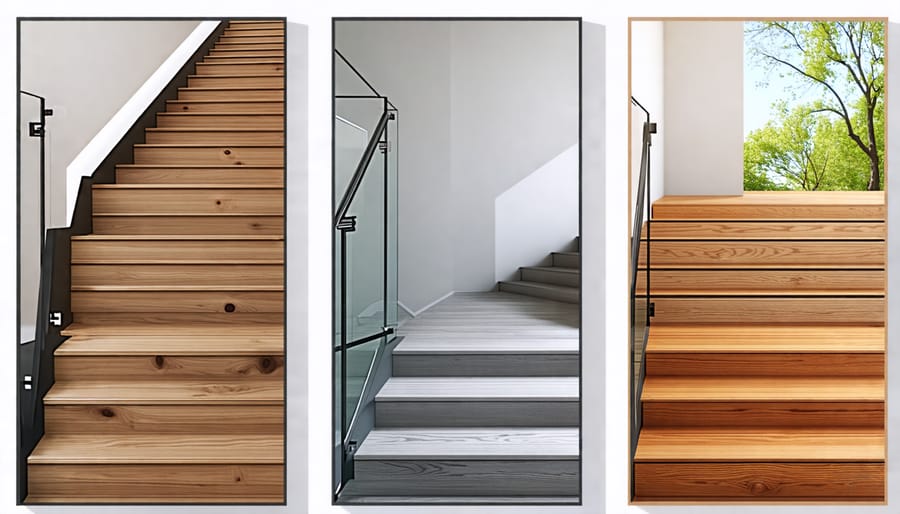
Decoding Stair Rail Parts: Elevate Your Home with Every Step
Identify and familiarize yourself with the key components of a stair railing: the handrail, balusters, newel posts, and base rail. Recognize that each part serves a functional and aesthetic purpose. Choose materials that align with your home’s design and your personal style preferences; options include wood, metal, and glass. Measure accurately before purchase or installation to ensure a precise fit, avoiding costly mistakes or mismatches in style. Securely attach the handrail and balusters using appropriate tools and techniques to guarantee safety and stability over time.
Anatomy of a Stair Railing

Balusters
Balusters are the vertical pillars that support the handrail, providing both safety and style to a staircase. They’re essential for preventing falls and ensuring stability. Design options for balusters are vast, ranging from traditional turned wood styles to sleek metal or glass variations that suit any aesthetic. Materials like wood, wrought iron, stainless steel, and acrylic offer diverse choices to match your interior decor. For a DIY enthusiast, installing balusters can be a rewarding project, allowing creativity through custom patterns or finishes. Balusters not only enhance the visual appeal of your stair railing but also add a personal touch to your space.
Handrail
A handrail is the smooth, supportive beam that runs alongside stairs, offering safety and balance to those ascending or descending. It’s an essential component of stair railings, particularly for children, the elderly, and anyone needing a little extra stability. Handrails come in various materials like wood, metal, and even glass, allowing you to match them seamlessly with your home’s decor. When designing your handrail, consider the spacing from the wall, height comfort, and style integration. Whether you’re planning a DIY project or a professional installation, the right handrail can beautifully enhance both functionality and aesthetic appeal of your staircase.
Newel Post
Newel posts are the unsung heroes of staircases, offering both style and stability. These sturdy, vertical pillars anchor the railing system, ensuring it remains secure and safe. Located at the top and bottom of a staircase, and sometimes at turns or landings, newel posts provide critical structural support. Without them, your railing could wobble or become unstable, posing a safety risk. For DIY enthusiasts, installing a newel post is a rewarding project that can transform the look of your staircase while boosting its durability. Choose a design that complements your home, and you’ll enhance both form and function effortlessly.
Connecting Elements and Accessories
Bolts and Screws
Bolts and screws are essential hardware in securing the components of a stair railing, ensuring stability and safety. Choosing the right type is crucial, especially when dealing with challenges like uneven floors. For example, lag bolts are robust choices for anchoring posts to wood. For metal railings, consider machine screws which offer reliable support. Deck screws, known for their corrosion resistance, work well in outdoor settings. Always select the appropriate size to match your materials, and ensure a snug fit to prevent any wobble or safety hazards over time.
Base Rail
The base rail serves as the foundation of your stair railing, providing essential support for the balusters, which are the vertical posts that help hold up the handrail. This sturdy piece lies horizontally along the stairs, ensuring that the balusters remain securely in place and the railing maintains its integrity. Beyond its functional purpose, the base rail also offers opportunities for decorative flair. Available in various materials like wood and metal, it can feature intricate designs or a sleek, minimalist look to complement your staircase’s style. Opting for a decorative base rail can add a touch of elegance and enhance the overall aesthetic of your home’s stairway.
Rail Brackets and Fittings
Rail brackets and fittings are vital in securing and stabilizing stair railings. These components connect the handrail to the wall or posts, ensuring safety and structural integrity. With various styles available, they add both function and flair to any staircase, making them an essential consideration in railing design and installation.
Material Choices for Stair Railings

Wooden Railings
Wooden stair railings offer a timeless appeal that seamlessly blends with various interior designs. They are available in a multitude of finishes and types, such as oak, maple, or walnut, allowing homeowners to personalize their space. Wooden railings can be crafted into intricate designs for a classic look or kept simple for a modern aesthetic, making them a versatile choice for any setting. For DIY enthusiasts, installing or refurbishing wooden railings can be a fulfilling project. The warmth and elegance they add not only enhance the visual appeal but also potentially increase property value. Embrace creativity while ensuring safety and compliance with building codes.
Metal Railings
Metal railings offer a perfect blend of durability and style, making them a favored choice for both indoor and outdoor stairs. Known for their resilience, metal railings can withstand daily wear and tear, and with options like wrought iron, stainless steel, and aluminum, there’s a variety to match any aesthetic. Opt for sleek stainless steel for a modern vibe, or choose ornamental iron for a classic touch. Installing metal railings can also be a satisfying DIY project. Ensure safety and creativity by selecting designs that complement your home’s look while providing sturdy support for years to come. Embrace the beauty and strength of metal railings to enhance your space!
Glass and Other Modern Materials
Glass railings have become a popular choice for their sleek, modern look and ability to open up a space. They offer an unobstructed view, making them perfect for showcasing stunning staircases. Paired with metal or wooden handrails, glass panels bring a contemporary touch that’s both stylish and functional, enhancing light flow and creating a sense of openness.
DIY Tips for Stair Railing Installation
Thinking about tackling a stair railing installation? With the right planning and tools, you can achieve a professional-looking result on your own. Start by identifying the key components: balusters, handrails, newel posts, and base rail if applicable. Measure your staircase to determine the necessary lengths and quantities, ensuring you purchase materials that match your desired style and durability needs. Use a level and tape measure to mark where the newel posts will be mounted, as they serve as the foundation for your railing. When cutting handrails, use a miter saw for precise angles, and always double-check your measurements. Balusters should be evenly spaced, adhering to local building codes for safety. Secure all components with quality screws or brackets to ensure stability.
Remember, patience and precision are your best tools. Taking the time to carefully plan and execute each step will pay off in both the functionality and appearance of your finished stair railing.
Conclusion
Understanding the components of a stair railing can elevate your design projects from ordinary to inspired. By mastering the terminology and the interplay between balusters, handrails, and newel posts, you can effectively plan and execute your next home improvement project, whether for personal enjoyment or real estate enhancement. Incorporating cozy home ideas into your railing design can further harmonize the elements of your space, making it both functional and aesthetically pleasing. As you explore these possibilities, envision how they can transform your solo DIY projects or professional designs.
